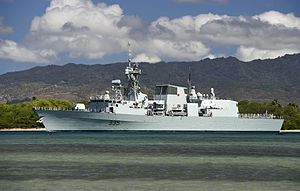Halifax-class frigate

HMCS Calgary in July 2014
|
|
| Class overview | |
|---|---|
| Name: | Halifax class |
| Builders: | |
| Operators: |
|
| Preceded by: | Annapolis class |
| Succeeded by: | Single Class Surface Combatant |
| In commission: | 29 June 1992–present |
| Completed: | 12 |
| Active: | 12 |
| General characteristics | |
| Type: | Guided missile frigate |
| Displacement: | 4,770 t (4,770.0 t) |
| Length: | 134.1 m (439.96 ft) |
| Beam: | 16.4 m (53.81 ft) |
| Draught: | 4.9 m (16.08 ft) |
| Propulsion: |
|
| Speed: | 29 kn (54 km/h; 33 mph) |
| Range: | 9,500 nmi (17,600 km; 10,900 mi) |
| Complement: | 225 |
| Sensors and processing systems: |
|
| Electronic warfare & decoys: |
TKWA/MASS (Multi Ammunition Softkill System) |
| Armament: |
|
| Aircraft carried: | 1 × CH-124 Sea King or 1 × CH-148 Cyclone helicopter |
The Halifax-class frigate, also referred to as the City class, is a class of multi-role patrol frigates that have served the Royal Canadian Navy since 1992. The class is the product of the Canadian Patrol Frigate Project, which dates to the mid-1970s.HMCS Halifax was the first of an eventual twelve Canadian-designed and -built vessels which combine traditional anti-submarine capabilities with systems to deal with surface and air threats as well. All ships of the class are named after a major city in each province (St. John's, Halifax, Charlottetown, Fredericton, Québec City, Toronto, Winnipeg, Regina, Calgary and Vancouver) plus the cities of Ottawa and Montreal.
In 2007 the Canadian government announced a planned refit of the Halifax class which known as the Halifax Class Modernization Project (HCMP) of which the Frigate Life Extension (FELEX) project is a part. In November 2008, a Lockheed Martin Canada-led team including Saab AB, Elisra, IBM Canada, CAE Professional Services, L-3 Electronic Systems and xwave, was awarded the contract. The construction phase of the program was completed in November 2016. The Halifax-class modernization program is currently underway and is scheduled to complete the refit and modernization of all twelve ships of the class by 2018.
In October 2011 the Canadian government launched the National Shipbuilding Procurement Strategy which aims to replace the Halifax class, as well as the capabilities of the Iroquois-class destroyers, with up to 15 (but likely fewer) new warships under the Single Class Surface Combatant Project. This replacement class is currently in the design stage and construction is anticipated to begin in the early 2020s.
The Halifax-class frigate design, emerging from the Canadian Patrol Frigate Program, was ordered by the Canadian Forces in 1977 as a replacement for the aging St. Laurent, Restigouche, Mackenzie, and Annapolis classes of destroyer escorts, which were all tasked with anti-submarine warfare. In July 1983, the federal government approved the budget for the design and construction of the first batch of six frigates, with a second batch ordered in December 1987. To reflect the changing long term strategy of the Navy during the 1980s and 1990s, the Halifax-class frigates was designed as a general purpose warship with particular focus on anti-submarine capabilities.
...
Wikipedia
